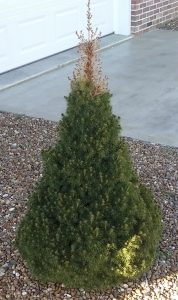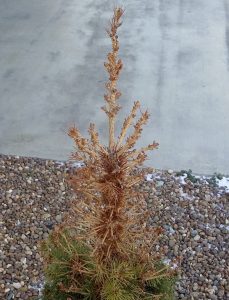Question & Answer
Likely culprits of dieback
Q. This is one of our two dwarf Alberta spruce trees. In the fall we noticed the very top of one turning brown; it kept getting worse from top down, and we noticed white webs. We took a picture of it, took it to a local nursery and showed them the picture. They said it was spider mites. We bought a systemic insect control and used per directions seven days apart with three doses. We did not see more webs. But it was still turning brown, so put another dose on. It is still turning brown farther down even now, still in January. Any ideas on what to do to save this tree? — SR, Martin County
A. There are many potential causes for dieback of dwarf Alberta spruce — or any spruce. Certainly, spider mites can be a problem, especially likely in hot, dry weather. When the top of the tree dies first, some of the most likely culprits are problems with the root system and/or the trunk of the tree. The most common suspects include root rot from waterlogged soil; compacted soils, resulting in poor aeration of the roots; excessively droughty soil; “mower or weed whip blight,” causing injury to the trunk; planting too deeply, especially in heavy soil; and twine or wire left around the trunk of the tree at planting. Rodent damage can also cause significant damage to the trunk. You mention only one of the trees are affected. Are they planted near each other under similar growing conditions? It does appear that the one in the picture is potentially planted too deep, since it seems to be sited with the lowest branches directly on top of the gravel mulch. How much of the trunk is buried in the gravel?
Unfortunately, there is no way to restore the top of the tree; it cannot replace the dead needles. The tree will always appear disfigured even it survives. Your best bet would be to replace the tree this spring, but I advise choosing a different species until and unless you can get this problem diagnosed. Purdue Publication ID-477, Stress-related Conifer Dieback provides more information on the possible causes. You might consider taking additional photos, and perhaps an actual sample of a branch that still has some green in addition to the brown needles, to your local county office of Purdue Extension. Or you can submit directly to the Purdue Plant and Pest Diagnostic Lab.
Q. I have several amaryllis that did not bloom last year and so far haven’t bloomed this year. I fed them during the summer; they got plenty of morning sun and water. I brought them in sometime in October, put them in my basement, and then brought them up in early December. So far, no leaves are coming up, but the top of the bulb has green on it, so I don’t think it’s dead. They have not been transplanted and have about 3 or 4 inches between the bulb and the pot. I would welcome any suggestions. — BM, Ramsey, Indiana.
A. Amaryllis bulbs require significant rebuilding of food reserves (carbohydrates) in the bulb in order to bloom again. After their blooms fade, they need lots of sunlight, such as out in the garden in full sun after danger of frost has past. Morning sun might not be quite enough to replenish the carbs. As the plants fade at the end of summer, cut the stem off and air-dry the bulb and store in a cool, dry place. Amaryllis bulbs require a resting period of 8-10 weeks at about 45-55 F. Then it’s time to repot, moisten the soil, but keep on the dry side until growth emerges. Be sure the top one-third to one-half of the bulb shows above the top of the soil. Flowers should appear in 6-8 weeks following potting. More information can be found in Purdue Extension Bulletin HO-19, Forcing Bulbs for Indoor Bloom.

